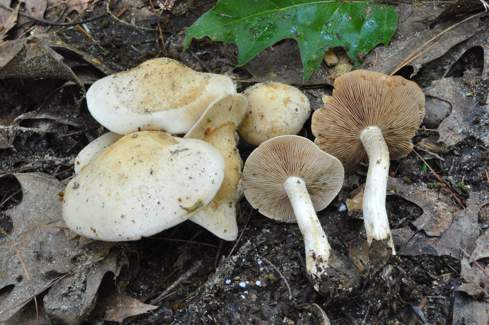 Hebeloma subaustrale (Photo: N. Siegel)
Hebeloma subaustrale (Photo: N. Siegel)Taxonomy
Full name: Hebeloma subaustrale Murrill, Lloydia 8: 287 (1946) ["1945"]Genus: Hebeloma
Section: Naviculospora
Types: UNITED STATES: Florida: Gainesville, Alachua Co. (approx. 29.6516°N, 82.3248°W, alt. approx. 50 m a.s.l.) on grassy, shady soil in lawn, 30 Oct. 1941, G.F. Weber, det: W.A. Murrill (Holotype. herbarium acc. no. FLAS-F-19345, HJB1000402; Isotype. herbarium acc. no. TENN-F-021177, HJB1000447).
Heterotypic synonyms:
- Hebeloma angustisporium Hesler, Kew Bulletin 31 (3): 301 (1977)
- Hebeloma perangustisporium Hesler, Kew Bulletin 31 (3): 478 (1977)
- arrow_drop_downarrow_drop_upEtymologyThe specific epithet emphasizes the macroscopic similarity with Hebeloma australe.
- arrow_drop_downarrow_drop_upOriginal diagnosisPileo convexo-expanso, 3-4 cm. lato, subviscido, glabro, pallido-roseo, raphanico; lamellis sinuatis, latis, confertis; sporis subovoidcis, pallidis, levibus, 8-10 X 4-4.5 μ; stipite acquali, pallido, 3 X 0.5 cm.
- arrow_drop_downarrow_drop_upEnglish translationPileus convex to applanate, 3-4 cm broad, slightly viscid, glabrous, pale pink, with raphanoid smell; lamellae sinuate, broad, crowded; spores subovoid, pale, smooth, 8-10 x 4-4.5 μ; stipe equal, pale, 3 x 0.5 cm.
References
Description
- arrow_drop_downarrow_drop_upThresholds
Description of Hebeloma subaustrale based on 8 collections
- arrow_drop_downarrow_drop_upMacroscopic descriptionPileus: (20) 32–45 (46) mm diameter; shape usually convex, occasionally umbonate; characters occasionally remains of universal veil; margin characters often smooth, occasionally scalloped; viscosity tacky when moist; colour variation often unicolour, occasionally two color; colour at centre cream.
Lamellae: attachment usually emarginate, occasionally adnate or adnexed; maximum depth not recorded; number of complete lamellae 80–92; presence of tears absent; white fimbriate edge usually present, occasionally absent.
Cortina presence: no.
Stipe: 30–56 (70) x 5–10 (11) {median} x 5–13 (14) {basal} mm; stipe Q 3.5–8.0; base shape often clavate or cylindrical; floccosity pruinose at apex; rooting no; thick rhizoids at base absent;
Context: Texture firm; stipe interior often hollow or stuffed; stipe flesh discolouring no; slenderness measure 2.7–11.1; smell often raphanoid, occasionally earthy or weakly raphanoid; taste often raphanoid, occasionally weakly raphanoid where recorded.
Spore deposit colour: cinnamon.
Exsiccata characters: hard, occasionally stipe blackening.
- arrow_drop_downarrow_drop_upMicroscopic descriptionSpores: shape amygdaloid, usually fusoid, rarely navicular; colour in microscope yellow; guttules usually no, occasionally yes. papilla no; Spore Code: O1 O2; (P0) P1 (P2); D2 D3.
Basidia: 19–32 x 5–6 (7) μm; ave. Q 3.8–4.6; spore arrangement 4 spored;
Cheilocystidia: main shape cylindrical, usually ventricose, often clavate, occasionally clavate-lageniform or clavate-ventricose or gently clavate, rarely capitate-stipitate or clavate-stipitate; special features observed often septa, occasionally irregular, many collapsed in exsiccata, apical thickening or grotesque, rarely branching, short or subcapitate; cheilocystidia ratios: A/M = 1.04–1.48; A/B = 0.84–1.31; B/M = 1.20–1.36.
Pleurocystidia: none seen.
Ixocutis: epicutis thickness (measured from exsiccata) up to 100 μm; ixocutis hyphae width up to 7 μm; ixocutis hyphae encrustation variable; shape of trama elements beneath subcutis ellipsoid or thickly sausage-shaped, often cylindrical up to 13 μm wide.
Caulocystidia: Similar to cheilocystidia but larger, up to 100 μm.
- arrow_drop_downarrow_drop_upSpore measurements
- arrow_drop_downarrow_drop_upCheilocystidia measurements
- arrow_drop_downarrow_drop_upHabitat and distributionHebeloma subaustrale's preferred habitat appears to be lawn, montane, subtropical woodland or mixed woodland with soil or grassy, shady soil. Where only one possible associate was recorded, that associate has always been Quercus (family Fagaceae). We have additional records where Pinus, Abies and Fagus were recorded as possible associates, but in these cases a number of possible associates were mentioned. Overall the most commonly recorded families are Fagaceae (66.7%) and Pinaceae (33.3%) The growth habit of our collections was often gregarious and occasionally caespitose or scattered.
According to our current collections, the species is found only in Northern America. On the continent, collections has been found in the WWF biomes The World Wildlife Fund (WWF) have divided the world into 867 terrestrial ecoregions. The ecoregion here is estimated by mapping from the GPS coordinates of the collection using data made available by Dinerstein et al (2017). Use this webtool to explore the ecoregions visually or see a full list of current ecoregions on Wikipedia. temperate broadleaf & mixed forests (62.5%), temperate grasslands, savannas & shrublands (25.0%) and tropical & subtropical coniferous forests (12.5%), specifically including the ecoregions: Appalachian-Blue Ridge forests (25.0%), Southeast US conifer savannas (25.0%), Trans-Mexican Volcanic Belt pine-oak forests (12.5%), Southern Great Lakes forests (12.5%), Northeast US Coastal forests (12.5%) and New England-Acadian forests (12.5%). From collector information, it appears collections have been found in the 1.4 Forest – Temperate (40.0%), 14.5 Urban Areas (40.0%) and 1.9 Forest – Subtropical/tropical moist montane (20.0%) IUCN habitats We map from the collector's description of the habitat to the International Union for Conservation of Nature (IUCN)'s definition using a standardised set of rules. Please see this page for a full list of IUCN habitats.. Within Northern America we have records from Southeastern U.S.A. (Tennessee and Florida), Northeastern U.S.A. (Ohio, Pennsylvania and New Hampshire) and Mexico (Mexico).
- arrow_drop_downarrow_drop_upCommentaryThe small weakly ornamented basidiospores together with the short irregular cheilocystidia, often cylindrical but also both ventricose and clavate, suggest Hebeloma sect. Naviculospora, which is supported by molecular data. Within this section H. subaustrale is differentiated from other Northern American species of this section by the average basidiospore length (a maximum of 10 μm), and average spore Q greater than 1.7, together with the cheilocystidia that have a maximum average A/B ratio of 1.5 and a minimum average B/M ratio of 1.2. We were not able to generate any sequence data from the type of H. subaustrale. However, our morphological study of the type, and of a number of other species within H. sect. Naviculospora, leaves us in no doubt that this is a conspecific of both H. angustisporium and H. perangustisporium. For these latter two species types we have good morphological and molecular data. Table 1 (Eberhardt et al. 2022) shows a comparison of the most important taxonomic parameters for the holotypes of these three species. The spore size and the average cheilocystidium shape, despite their irregularity, are key to differentiating species within this section. A full discussion can be found in Eberhardt et al. (2022).
Geographic distribution
Phenology
- arrow_drop_downarrow_drop_upAdditional cited collections